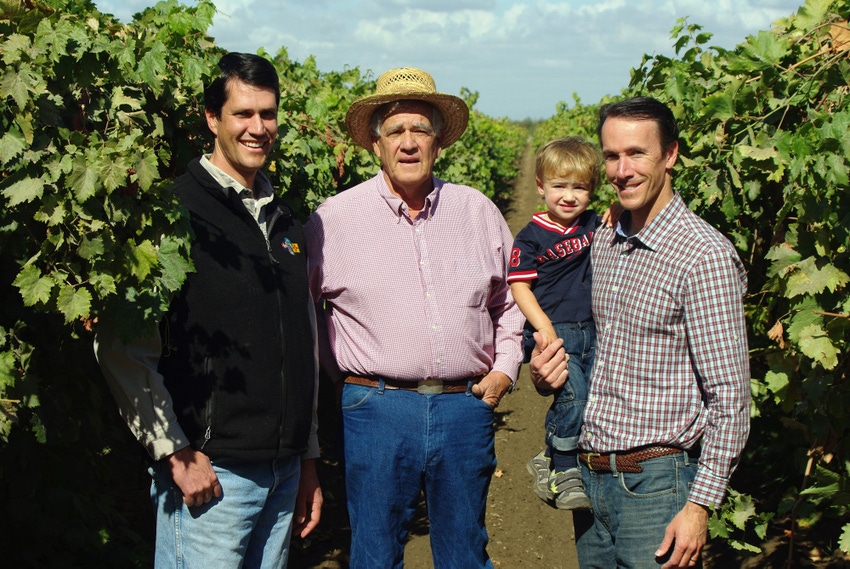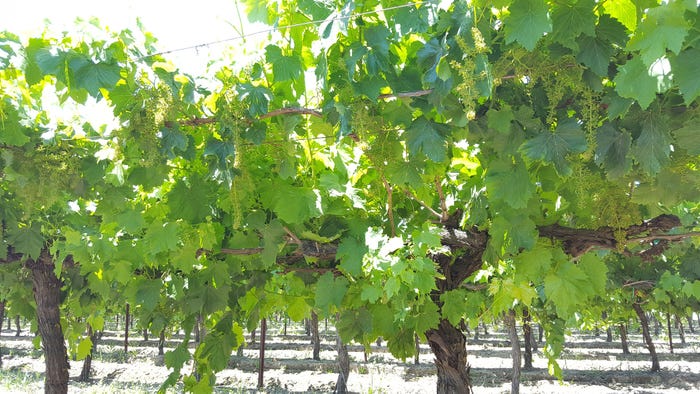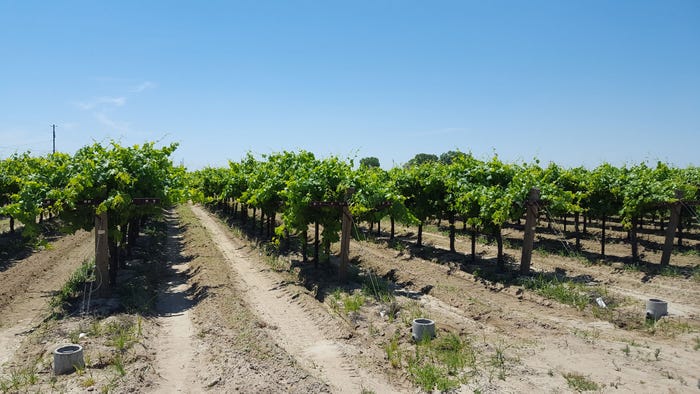
The 2017 bloom began in Chandler Farms’ 100 acres of vineyards near Selma, Calif., when 20 acres of Fiesta raisin grape vines started flowering the second week of May. Within a week after that the Rubired wine grape vines in the remaining 80 acres were also blooming.
“We’re off to a pretty normal start,” says Tom Chandler.
The early-season progress was aided by early spring rainfall plus ample supplies of surface water. “The canals are full, the basins are completely recharged, and the water table is slowly rising,” he says. "I am projecting the biggest crop we have had in over five years in our wine grapes. Other growers in the area are also expecting about a 25-percent increase in yield across the board.
At this early point, he’s less certain about the prospects for his Fiesta grapes. Based on last year’s yields, he’s expecting above-average yields this season.
This dried-on-the vine raisin variety was planted in 1999, replacing Muscat wine grape vines. About eight or nine years ago the Fiesta yields started alternating between larger crops one year and smaller crops the next.
“It’s kind of a unique situation,” he says. “We’re not sure what’s causing it. Changing our pruning and fertilizing practices hasn’t reduced the annual variation in production. The alternate bearing became more pronounced during the drought. Now we’re wondering if it’s related to the Harmony rootstock.
“We’re learned that it’s very water-sensitive. But Fiesta grows very vigorously. As a result, we really have to be on top of our irrigation to make sure the vines get all the water they need.”
That shouldn’t be a problem this year.
“The drought went away for us in March,” says Chandler, whose vineyards lie within the Consolidated Irrigation District. “Typically, we start getting deliveries of surface water sometime in April or May. But this year, right after the big floods farther north in the valley in March, we were able to take as much water as we wanted. We’re not in jeopardy of losing wells, like we were during the drought.”
Measurements at one monitoring site near his farm showed the local water table rose two to five feet in March, Chandler reports.

Fiesta raisin grapes on an open gable trellis system, Selma, Calif.
Prior to the drought, his water table was 70 feet below the soil surface, and most of his wells were 100 feet deep. Due to draw down of the water from increased pumping for irrigation during the drought, he lost some of his wells. That prompted Chandler to develop new wells to depths of 300 feet. Meanwhile, other growers in his areas dealt with dropping water tables by drilling new wells as deep as 600 feet.
Earlier this year, Chandler had the soils in his Fiesta field tested to determine their suitability for storing water over the winter.
“We don’t have enough surface water storage capability in this area,” Chandler says. “So, like some other farmers around, we’re looking at the possibility of putting surface water on our vineyards to recharge our groundwater supplies during wet winters, like this last one.”
He represents the latest generation to operate his family’s farm which dates back to 1889. Although the current vineyard acreage is much less that it once was, wine and raisin grapes have long been a part of the farm’s crop diversity. The current crop mix also includes peaches, plums, citrus and almonds.
The family began growing almonds in the late 1980s. Almond production began to increase significantly in the late 1990s, as new plantings of the trees replaced less-profitable Thompson Seedless vines.

Fiesta raisin grapes on an open gable trellis system, Selma, Calif.
Still, despite the reduction in wine and raisin grape acreage over the years, Chandler wants to remain in the wine industry. In fact, before returning to the family’s farming operation several years ago, he worked for a couple of different family wine grape vineyards in Sonoma County.
His father, Bill, was a founding member of the Central California Winegrowers Association and served on its board of directors. This group was a predecessor of the San Joaquin Valley Winegrowers Association, where Tom is a member of the board and treasurer.
“Our family likes to grow grapes, and we want to stay diversified with a crop that doesn’t require a lot of production inputs,” Tom says. “Besides, the San Joaquin Valley is a great place to grow grapes. We’d like to plant more wine grapes. But, currently, we’re facing tough competition from foreign growers who can ship their juice to wineries in California at prices less than we can provide the grapes. So, until the economics improve for us, our plans to expand wine grape production are on hold.”
About the Author(s)
You May Also Like




